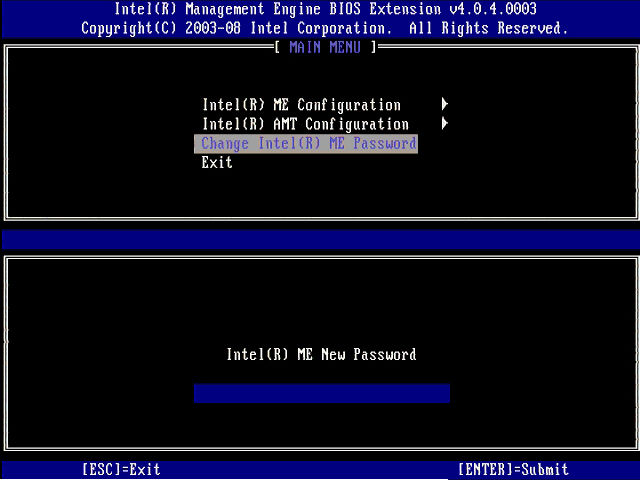

- #WHAT IS INTEL MANAGEMENT ENGINE FIRMWARE FOR FREE#
- #WHAT IS INTEL MANAGEMENT ENGINE FIRMWARE SERIAL#
- #WHAT IS INTEL MANAGEMENT ENGINE FIRMWARE FULL#
- #WHAT IS INTEL MANAGEMENT ENGINE FIRMWARE SOFTWARE#
#WHAT IS INTEL MANAGEMENT ENGINE FIRMWARE SERIAL#
Other features require the PC to be powered up (such as console redirection via serial over LAN (SOL), agent presence checking, and network traffic filtering). Most AMT features are available OOB, regardless of PC power state. The communication channel is independent of the PC's power state, the presence of a management agent, and the state of many hardware components such as hard disk drives and memory.

Intel AMT uses a hardware-based out-of-band (OOB) communication channel that operates regardless of the presence of a working operating system. Intel AMT is security and management technology that is built into PCs with Intel vPro technology. Intel AMT includes hardware-based remote management, security, power management, and remote configuration features that enable independent remote access to AMT-enabled PCs.
#WHAT IS INTEL MANAGEMENT ENGINE FIRMWARE FULL#
Only basic modes of access are supported, without full access to the encrypted communications of the complete purchased management system.
#WHAT IS INTEL MANAGEMENT ENGINE FIRMWARE SOFTWARE#
Intel itself provides a developer's toolkit software package which allows basic access to iAMT, but is not intended to be normally used to access the technology. iAMT cannot be fully utilized to its maximum potential without purchasing additional software or management services from Intel or another 3rd party independent software vendor (ISV) or value added reseller (VAR).
#WHAT IS INTEL MANAGEMENT ENGINE FIRMWARE FOR FREE#
Additional major security flaws in the ME affecting a very large number of computers incorporating Management Engine, Trusted Execution Engine, and Server Platform Services firmware, from Skylake in 2015 to Coffee Lake in 2017, were confirmed by Intel on Novem(SA-00086).Īlthough iAMT may be included for free in devices sold to the public and to small businesses, the full capabilities of iAMT, including encrypted remote access via a public key certificate and automatic remote device provisioning of unconfigured iAMT clients, are not accessible for free to the general public or to the direct owners of iAMT equipped devices. Some manufacturers, like Purism and System76 are already selling hardware with Intel Management Engine disabled to prevent the remote exploit. Every Intel platform with either Intel Standard Manageability, Active Management Technology, or Small Business Technology, from Nehalem in 2008 to Kaby Lake in 2017 has a remotely exploitable security hole in the ME. Intel confirmed a Remote Elevation of Privilege bug ( CVE- 2017-5689, SA-00075) in its Management Technology on May 1, 2017. AMT provides similar functionality to IPMI, although AMT is designed for client computing systems as compared with the typically server-based IPMI.Ĭurrently, AMT is available in desktops, servers, ultrabooks, tablets, and laptops with Intel Core vPro processor family, including Intel Core i5, Core i7, Core i9 and Intel Xeon E3-1200, Xeon E, Xeon W-1200 product family. AMT has moved towards increasing support for DMTF Desktop and mobile Architecture for System Hardware (DASH) standards and AMT Release 5.1 and later releases are an implementation of DASH version 1.0/1.1 standards for out-of-band management. AMT is built into PCs with Intel vPro technology and is based on the Intel Management Engine (ME). ĪMT is designed into a secondary (service) processor located on the motherboard, and uses TLS-secured communication and strong encryption to provide additional security. It gives a management application (and thus, the system administrator who uses it) access to the PC down the wire, in order to remotely do tasks that are difficult or sometimes impossible when working on a PC that does not have remote functionalities built into it. AMT is not intended to be used by itself it is intended to be used with a software management application. Hardware-based management has been available on Intel/AMD based computers in the past, but it has largely been limited to auto-configuration using DHCP or BOOTP for dynamic IP address allocation and diskless workstations, as well as wake-on-LAN (WOL) for remotely powering on systems.

Hardware-based management does not depend on the presence of an OS or locally installed management agent. Hardware-based management works at a different level from software applications, and uses a communication channel (through the TCP/IP stack) that is different from software-based communication (which is through the software stack in the operating system). Out-of-band (OOB) or hardware-based management is different from software-based (or in-band) management and software management agents. Intel Active Management Technology ( AMT) is hardware and firmware for remote out-of-band management of select business computers, running on the Intel Management Engine, a separate microprocessor not exposed to the user, in order to monitor, maintain, update, upgrade, and repair them.

A part of the Intel AMT web management interface, accessible even when the computer is sleeping


 0 kommentar(er)
0 kommentar(er)
